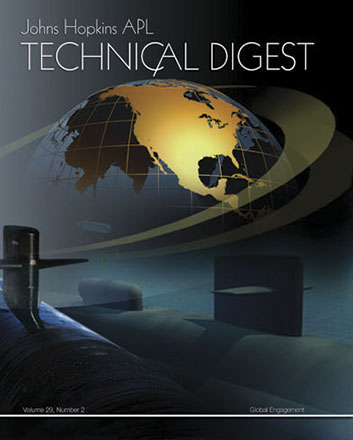
Global Engagement at APL
Volume 29, Number 2 (2010)
The Global Engagement Department performs work throughout all phases of a concept known as a “kill chain,” a sequential and orderly process to successfully engage and deliver the desired effects on a target (in other words, not necessarily to destroy a target). To deliver effects anywhere on the globe, the U.S. military must be able to detect and track targets, coordinate their activities via command and control systems, engage the targets in the manner expected, and then assess the results of their actions. This issue of the Johns Hopkins APL Technical Digest shares the achievements of the Global Engagement Department over the broad range of activities encompassed by the kill chain.
Global Engagement at APL: An IntroductionWilliam A. LaPlante Jr. |
The Origin and History of the Global Engagement DepartmentJoseph C. Schissler and John P. Gibson |
Guidance and Navigation in the Global Engagement DepartmentFrederick W. Riedel, Shannon M. Hall, Jeffrey D. Barton, James P. Christ, Brian K. Funk, Thomas D. Milnes, Peter E. Neperud, and David R. Stark |
Miniature Analog GPS Translator for Trident Reentry Body Accuracy AnalysisMichael H. Boehme |
Collecting Reentry Body GPS Translator Data Near Impact Using the Over-the-Horizon BuoyCarlyn H. Weaver |
Six-Degree-of-Freedom Digital Simulations for Missile Guidance, Navigation, and Control and Validation Test with USS FloridaGregory M. Horstkamp, Jerome R. Vetter, Charles J. McSoley, and Ward J. Szerlag |
A Concept for Command and ControlRobert R. Leonhard, Thomas H. Buchanan, James L. Hillman, John M. Nolen, and Timothy J. Galpin |
Command and ControlPeter M. Trask, Frederic T. Case, Steven L. Forsythe, Thomas M. McNamara Jr., Paul D. North, Kim E. Richeson, Christine O. Salamacha, and John J. Tamer |
Enhancing Systems Engineering Agility with Modeling and SimulationTimothy M. Frey and Matthew C. Valencia |